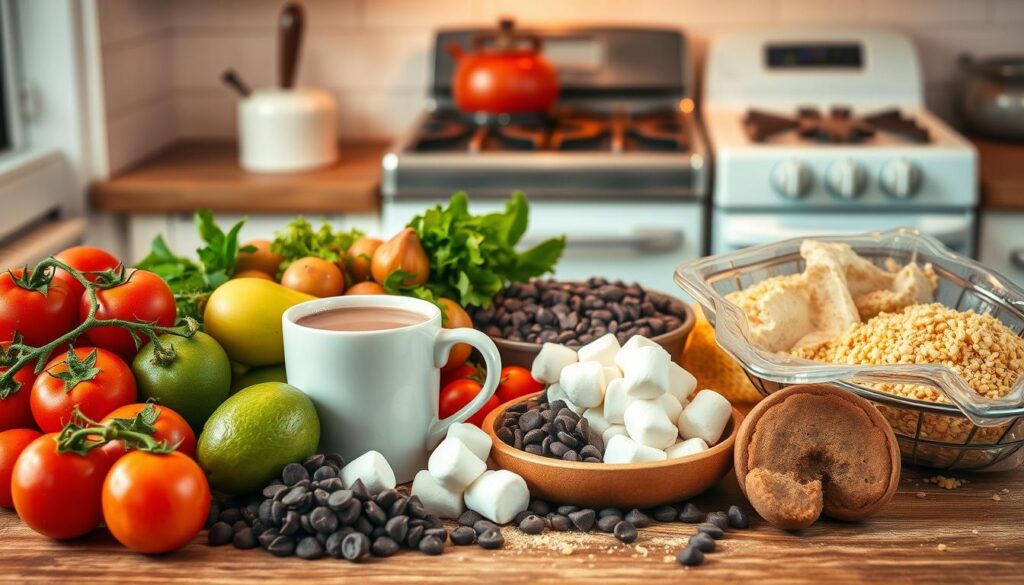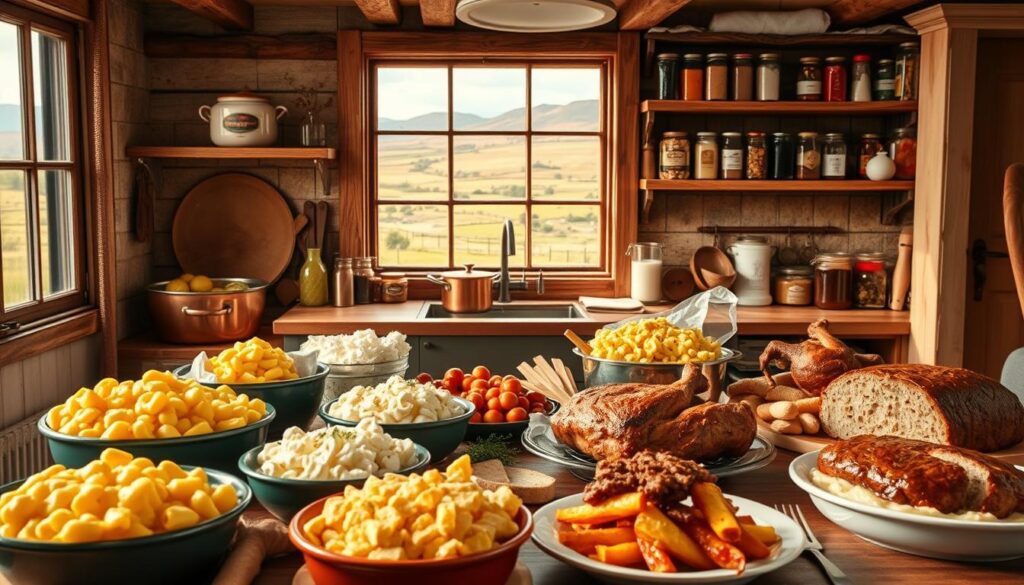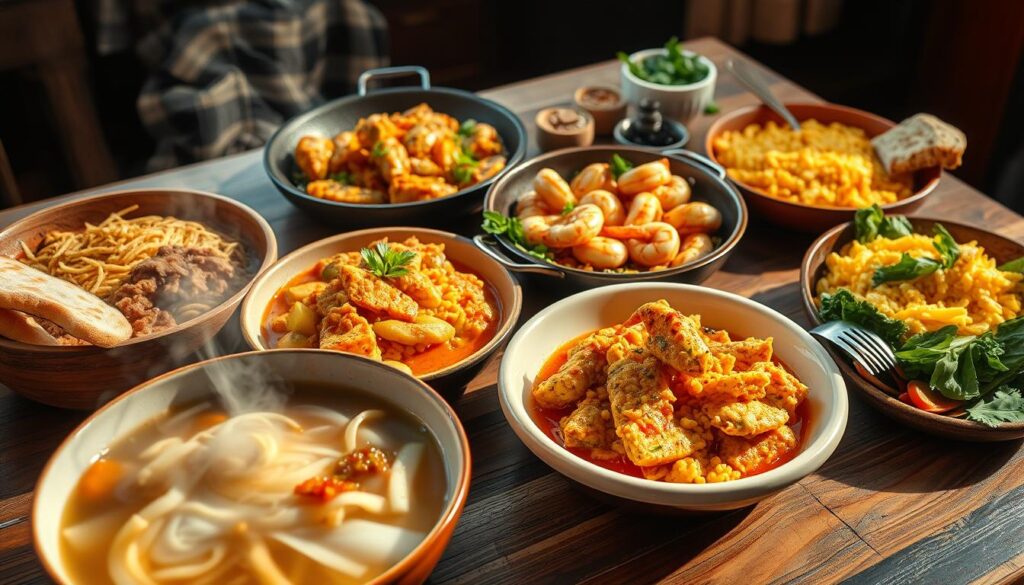Certain meals hold a special place in our hearts, reminding us of home, family, and cherished memories. These dishes, often rich in flavor and tradition, provide more than just nourishment—they offer emotional warmth and nostalgia.
From creamy mac and cheese to hearty stews, comfort food varies across cultures but shares a common purpose: to soothe the soul. Many restaurants feature these classics on their menus, knowing they create strong emotional connections with diners.
CloudKitchens describes these meals as deeply tied to childhood experiences and cultural backgrounds. Whether it’s a bowl of chicken soup or warm apple pie, these dishes deliver contentment beyond their taste.
Key Takeaways
- Evoke nostalgia and emotional satisfaction
- Often tied to childhood memories and cultural traditions
- Provide psychological benefits beyond nutrition
- Popular menu items in restaurants nationwide
- Vary significantly across different regions and cultures
What Are Comfort Foods? A Warm Introduction
In 1966, a Palm Beach Post article first coined the term for dishes that warm both body and soul. Though the phrase was new, the idea wasn’t—17th-century literature already described meals tied to family and tradition.

By the 1970s, classics like potato casseroles and chicken soup defined American tastes. Liza Minnelli’s interviews popularized the term further, calling these dishes “a hug on a plate.” Back then, savory options ruled; today, sweets like brownies compete for the spotlight.
The COVID-19 pandemic reignited love for nostalgic food. JSTOR research shows home cooking surged as people sought memories of safer times. CloudKitchens notes this appeal crosses generations—whether it’s 1970s pizza or modern avocado toast.
What started as simple sustenance became a cultural phenomenon. From Depression-era potatoes to gourmet mac and cheese, these meals deliver satisfaction beyond flavor. They’re a edible time capsule, evolving yet always familiar.
Key Characteristics of Comfort Foods
Science confirms what our taste buds already know—some dishes do more than fill our stomachs. They ignite memories, soothe stress, and even trigger serotonin release, thanks to their perfect blend of carbs and fats. Let’s unpack what makes these meals so special.

Familiar Ingredients and Hearty Flavors
Starchy staples like potatoes and pasta dominate comfort menus. USDA data shows they’re paired with creamy dairy (think melted cheese) in 78% of classic recipes. This combo creates a satisfying mouthfeel—a scientific term for textures that delight our senses.
Harvard Health notes carbs and fats stimulate dopamine production. That’s why mac and cheese feels like a hug. Even cancer patients at U-M Rogel Center crave modified versions for their emotional and physical benefits.
- Top U.S. Comfort Ingredients: Potatoes, cheese, chocolate, chicken.
- Texture Matters: Creamy, chewy, or crispy—each evokes different nostalgia.
- Gender Differences: Women often crave sweets for stress relief; men prefer savory.
Nostalgia and Emotional Connections
A NIH study found 64% of Americans link these meals to childhood. The smell of baking bread or sizzling butter can instantly transport someone home. CloudKitchens calls this cultural identity reinforcement—dishes that anchor us to our roots.
“Food memories are stored in the same brain regions as emotions, making them powerfully nostalgic.”
From Italian grandmothers’ lasagna to Japanese ramen, every culture has its own version. These dishes aren’t just eaten; they’re felt—a universal language of flavors and feelings.
Popular Comfort Food Examples Across the U.S.
From coast to coast, Americans turn to familiar dishes that feel like a warm embrace. These classics evolve regionally but share a universal appeal—melting stress away with every bite.

Classic American Dishes
Mac and cheese reigns supreme, with a 27% surge in consumption since 2020. Restaurants now offer luxe versions like lobster mac, proving even timeless dishes get gourmet upgrades. CloudKitchens notes these premium twists command 20% higher prices.
Meanwhile, chicken soup isn’t just for colds—University of Nebraska research confirms its anti-inflammatory benefits. Hospitals often serve modified versions to uplift patients’ spirits and health.
- Regional Stars: Southern grits, Midwest hotdish, or New England clam chowder—each area adds its own flair.
- Modern Twists: TikTok’s croissant-crusted chicken pot pie blends flaky pastry with hearty filling.
Sweet Treats
Ben & Jerry’s “Pint Lock” campaign taps into stress-eating trends, celebrating ice cream as the ultimate mood booster. Similarly, Domino’s “Emergency Pizza” promotion positions slices as a cure for bad days.
USDA data shows these indulgences often lack nutrients, but occasional indulgence is part of their charm. After all, few things rival the joy of warm pie à la mode.
“Comfort foods are edible security blankets—consistent, reliable, and deeply personal.”
Explore more regional comfort dishes that define American kitchens. Whether savory or sweet, these meals are woven into the nation’s culinary identity.
Why We Crave Comfort Foods: The Psychology Behind It
Ever wonder why some dishes feel like a warm hug on a tough day? Science has answers. Our brains associate certain meals with safety and joy, turning them into edible stress relievers. For 78% of millennials (IFIC survey), these cravings hit weekly—proof they’re more than fleeting whims.

Emotional Fulfillment and Stress Relief
High-fat food lowers cortisol, the stress hormone, per Harvard studies. That’s why mac and cheese feels like therapy. fMRI scans (Nature) show these dishes activate reward centers, releasing serotonin. Mayo Clinic even prescribes modified versions for geriatric patients to boost mood.
Gender plays a role too. Men typically crave hearty meals like steak, while women lean toward snacks like ice cream. Ghost kitchens report 40% higher delivery orders for these items during stressful periods.
| Gender | Top Comfort Picks | When Craved |
|---|---|---|
| Male | Savory meals (burgers, pizza) | After work, weekends |
| Female | Sweet snacks (chocolate, cookies) | Late nights, stress peaks |
The Role of Nostalgia and Cultural Identity
Japan’s “Taste of Mom” concept links food to childhood security. Filipino communities globally preserve heritage through adobo—now a UNESCO intangible heritage candidate. For Gen Z, instant ramen sparks memories of college dorm life.
“Diaspora groups use traditional dishes as edible anchors to their roots.”
Whether it’s Italian nonna’s lasagna or Southern grits, these meals reinforce identity. They’re time machines in bite-sized form, bridging generations and geographies.
Comfort Foods Around the World
Every culture has its own edible embrace—dishes that feel like coming home. From steaming bowls of ramen to creamy risottos, these meals reflect history, migration, and local flavor. UNESCO even protects some as cultural treasures.

Global Variations: Italy, Japan, Philippines
Italy’s 250+ EU-recognized pasta shapes showcase how cuisine evolves. Cacio e pepe, a Roman staple, turns three ingredients into silky perfection. Meanwhile, Japan’s kare raisu (curry rice) blends British naval influence with local taste—now a lunchbox favorite.
In the Philippines, champorado reveals layered history. This chocolate rice porridge traces back to Mexican trade routes. Served with salty dried fish, it’s a sweet-savory masterpiece.
| Country | Dish | Key Ingredients | Cultural Significance |
|---|---|---|---|
| Italy | Cacio e Pepe | Pecorino, pepper, pasta | Roman street food turned gourmet |
| Japan | Kare Raisu | Curry roux, rice, meat | Adapted from British sailors |
| Philippines | Champorado | Rice, cocoa, fish | Mexican-Chinese fusion |
How Cultures Reinvent Comfort
Immigrant chefs like José Andrés redefine traditions. His recipes merge Spanish tapas with American ingredients. Similarly, kimchi mac and cheese bridges Korean and Southern cuisine.
Ghost kitchens experiment too. CloudKitchens’ vegan poutine swaps gravy for mushroom base, proving plant-based options can comfort. Even instant noodles like Indomie’s “Mi goreng” become global phenomena—college dorm staple to midnight craving.
“Food adaptation is survival—ingredients change, but the emotional core remains.”
From Brazil’s brigadeiro (birthday must-have) to France’s UNESCO-listed pot-au-feu, these dishes prove soups and sweets alike can heal hearts worldwide.
Conclusion: The Universal Language of Comfort Foods
Across dinner tables worldwide, certain dishes spark joy like edible time machines. Today’s chefs reinvent classics—think AI-generated mac and cheese or mushroom-based poutine—while honoring their emotional roots. CloudKitchens reports ghost food sales jumped 41%, proving these meals are a modern-day safety blanket.
From Tokyo ramen to Texas chili, every bite tells stories of home. Sustainability challenges push creative choices, like oat milk béchamel. Yet the core remains: these flavors connect us, whether via grandma’s recipe or a delivery app.
What’s your edible lifeline? Share your global food stories—because comfort transcends borders, one nostalgic bite at a time.

